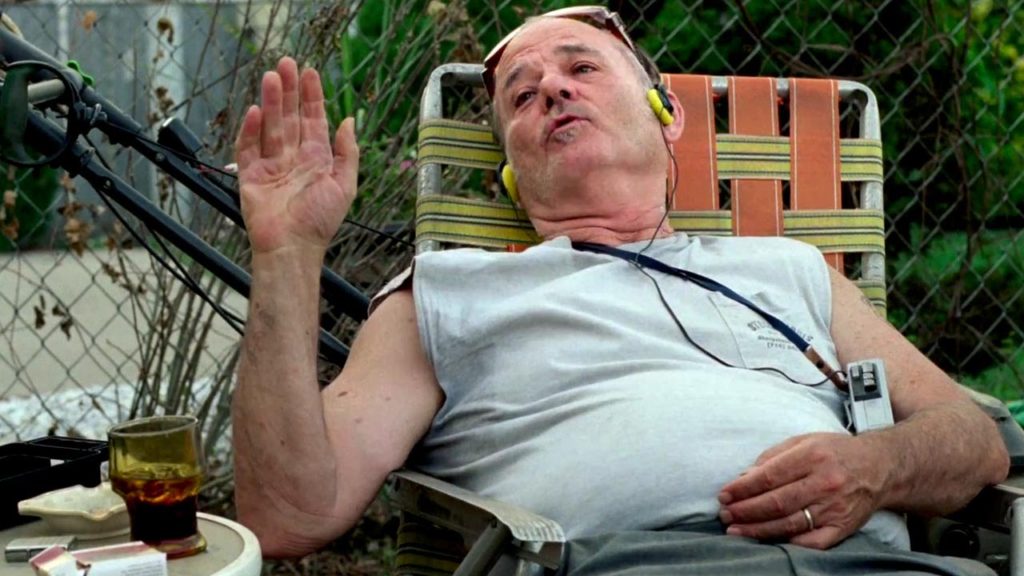Catching up With Everyone’s Favorite Sardonic Funny Man
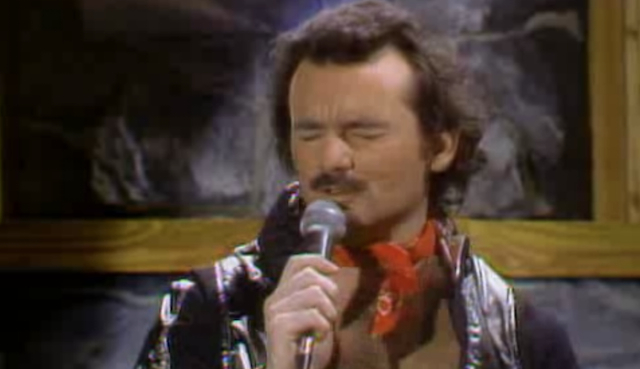
Murray belting it out on SNL.
Like most people I have “favorite” actors and actresses. You know, those we can trust to give us some enjoyment or appreciation no matter the role or general quality of the film. But I only have two that inspire something more, gratitude. When I think about their roles, when I think about their lives and how they have used their gifts, in my opinion to make the world a better place, I’m just thankful that I fell into a time and place where I’ve gotten to experience them. One of them is the late Robin Williams, the other is Bill Murray.
The origins of many comedians of the past 50 years often start with one of the big three: National Lampoon, The Second City out of Chicago, and the crown jewel, Saturday Night Live. Murray was involved in all three. By the time I was born in 1982, Murray had already departed SNL, launching his film career with movies that are still regularly viewed as classics. Ivan Reitman, director of 1979’s Meatballs, was insistent on Murray being in a film, any film, being that confident that Murray could carry it, and he wasn’t wrong. Meatballs, perhaps known more for the comedy camp genre it spawned than its quality, is a testament that time spent with Murray is never a bad thing. Other classic comedies would follow like Caddyshack (1980) and Stripes (1981), but it was the film Murray agreed to just to just get another film, The Razor’s Edge (1984), that epitomize Murray’s deadpan comedy, a little film called Ghostbusters.
Murray’s fame has only grown in the past decades as he has become an icon, almost a real live Puck that delights in just doing things because they may be funny or upset the norm.
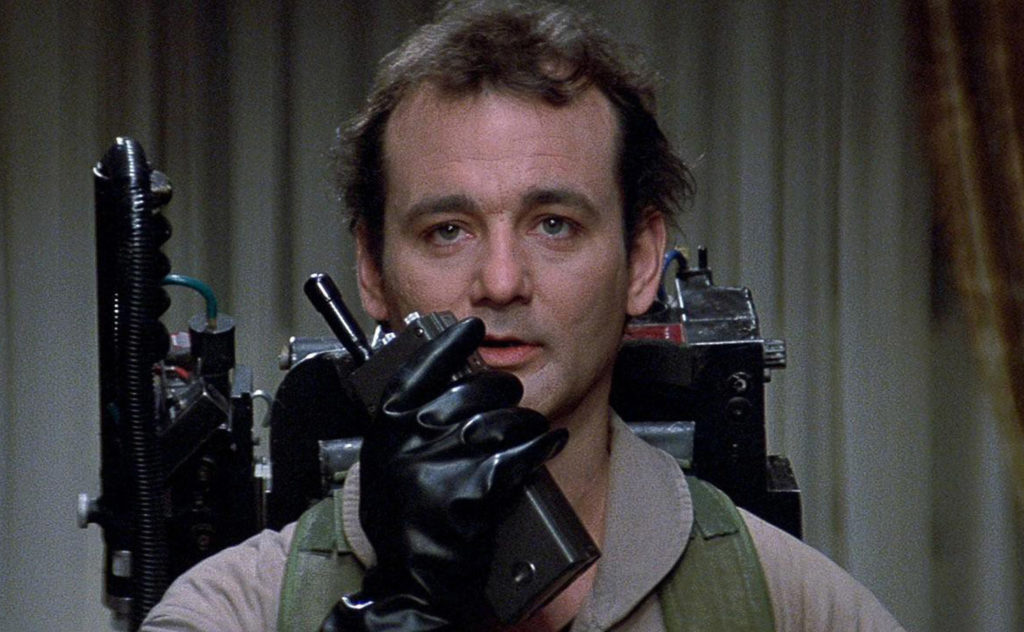
Ghostbusters (1984)
Being born in 1982 and only being two at the time of its release, my first exposure to Ghostbusters was actually the cartoon. The 80’s were the golden age of cartoons based on films, sometimes films that no child should be watching, like RoboCop or Rambo. Not even knowing what sarcasm or deadpan were, Peter Venkman was easily my favorite character, but the cartoon paled in comparison to the real thing, something I wouldn’t discover until 1990 when I rented it for the first time. For me Ghostbusters is everything a good comedy should be, infinitely quotable, played straight yet hilarious, stocked with iconic characters, and oozing with creativity and imagination, and Murray smirking at the whole premise, mocking the mayor, a deity, and pretty much any authority figure, assured my future as class clown and frequent visitor to the principal’s office.
The early 90’s delivered even more Murray classics and then it seemed that he faded a bit, but that was just to set the world up for more. In 10th grade, a friend and I went to the only indie theater in Tallahassee to see Rushmore (1998). Murray’s character, Harold Bloom, was an older Murray, more cynical and damaged, but just as funny and now even poignant. His collaborations with Wes Anderson have continued, and the world is better for it.
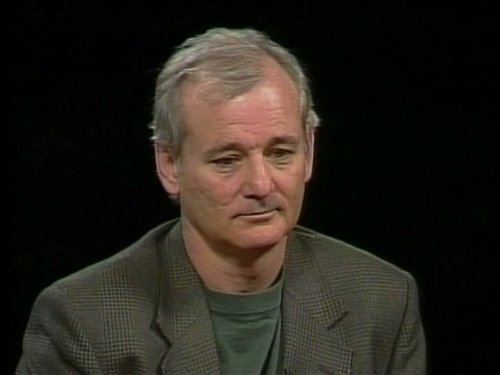 Murray’s fame has only grown in the past decades as he has become an icon, almost a real live Puck that delights in just doing things because they may be funny or upset the norm. The website Bill Murray Stories is filled with tales, some which may be fake but others that have the pictures to prove them, of Murray stepping into folk’s lives to deliver some nugget of wisdom or eat their fries (without asking), punt a football from an autograph-seeking fan and just give people a story and grin.
Murray’s fame has only grown in the past decades as he has become an icon, almost a real live Puck that delights in just doing things because they may be funny or upset the norm. The website Bill Murray Stories is filled with tales, some which may be fake but others that have the pictures to prove them, of Murray stepping into folk’s lives to deliver some nugget of wisdom or eat their fries (without asking), punt a football from an autograph-seeking fan and just give people a story and grin.
I’m never not in the mood to watch Bill Murray. Whether he’s the star or just making the most perfect cameo of an actor playing himself, he elevates every film he is in and has made my film-viewing experience better.
Enjoy these contributor’s first time experiences with some of his work, and, if you are like me, be grateful you know and have experienced Bill Murray. Some may be better, but not many. Thank you.
– Oscar Jackson
St. Vincent
(2014, The Weinstein Company, dir. Theodore Melfi)
by Max Foizey
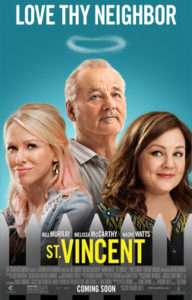 Vincent Mackenna (Bill Murray) lives alone, unless you count his cat Felix. Vincent makes sure Felix eats quality cat food, even as Vin gets by on sardines. Vin is a Vietnam veteran who keeps to himself, drinks far too much alcohol, and gambles away his meager funds at the horse track. Vin’s routine is interrupted when a moving truck plows into his fence and damages the tree in his front yard. Vin demands that his new neighbors pay for the damages, but you can tell he doesn’t care too much about the fence or tree, he just sees an opportunity for a payday.
Vincent Mackenna (Bill Murray) lives alone, unless you count his cat Felix. Vincent makes sure Felix eats quality cat food, even as Vin gets by on sardines. Vin is a Vietnam veteran who keeps to himself, drinks far too much alcohol, and gambles away his meager funds at the horse track. Vin’s routine is interrupted when a moving truck plows into his fence and damages the tree in his front yard. Vin demands that his new neighbors pay for the damages, but you can tell he doesn’t care too much about the fence or tree, he just sees an opportunity for a payday.
Although she questions how one can really pay for a tree, single mother Maggie (Melissa McCarthy) tells Vin she will take care of it. Through a twist of fate, a few days later Maggie’s young son Oliver (Jaeden Lieberher) ends up at Vin’s doorstep while his mom is stuck at work, and Vin agrees to babysit him – for a fee, or course.
From here on out we are treated to your typical man-from-the-wrong-side-of-the-tracks-teaches-a-young-boy-about-life-and-how-to-fight story, with strong work from both Murray and Lieberher.
Lieberher shows a lot of promise as Oliver, creating a sympathetic character who retains his dignity. Lieberher has since delivered on this promise with his starring roles in Midnight Special and the big screen adaptation of Stephen King’s IT. It’s always a treat to see Melissa McCarthy in a more dramatic role and she does a nice job as Maggie, the stressed out single mother. Here’s hoping McCarthy does more dramatic work soon.
We’ve seen Murray tap into this sort of character before, in films such as Broken Flowers and Lost in Translation, and one can only come to the conclusion that this easy melancholy must be somewhat present in Murray’s own life. Or, you know, maybe he’s just acting. Either way, I’d rank this up there with his most successful performances.
I’m not sure why Vincent has a long-standing relationship with a Russian lady of the night, and I’m not sure why that lady is portrayed by Naomi Watts. It’s not that Watts is bad in the role (she’s not), I’m just puzzled about the inclusion of the character in general, especially given what happens with her and Vin in the end.
St. Vincent doesn’t feature any music from Annie Clark (a missed opportunity), but it does feature an engaging script from Theodore Melfi, who wrote, directed, and produced the film two years before he would write, direct, and produce Hidden Figures. Like Hidden Figures, St. Vincent is a movie well worth watching even though it occasionally sinks into scenes saccharin enough to qualify for a TV movie of the week.
Olive Kittridge
(2014, HBO, dir. Lisa Cholodenko)
by Jim Tudor
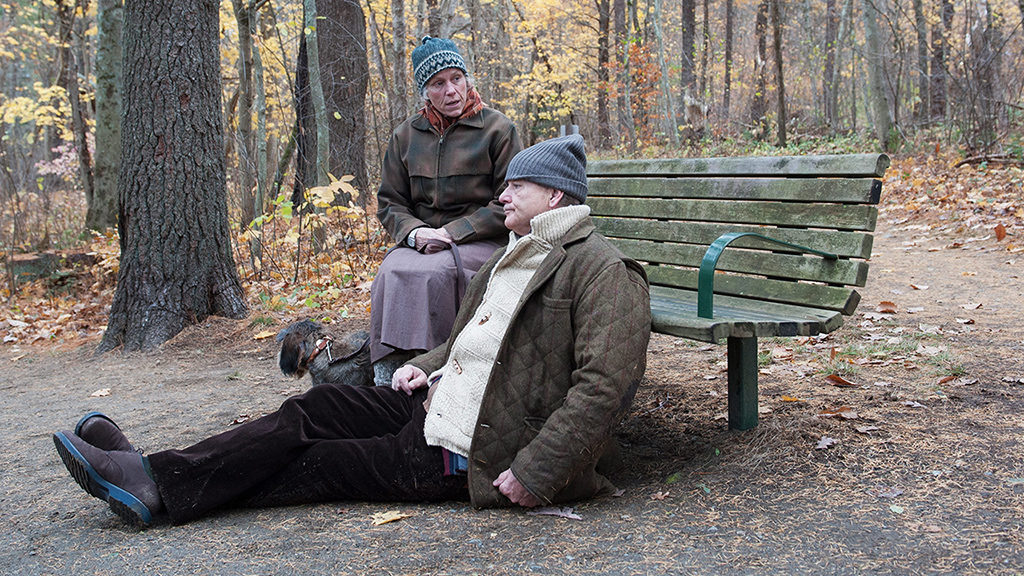
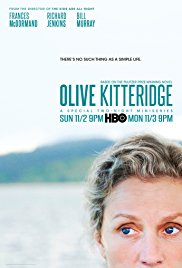 Nominated for gobs of Emmys and winning a bunch, the 2014 HBO mini-series Olive Kittridge is a beautiful rarity to discover. This four-part four-hour presentation tells the story of a couple of a certain age at various points in their lives. The couple, Olive and Henry Kittridge, are played flawlessly by Frances McDormand and Richard Jenkins. A schoolteacher and a pharmacist, respectively, we find the Kittridges’ nestled well in their coastal home in Maine, raising their son, Christopher.
Nominated for gobs of Emmys and winning a bunch, the 2014 HBO mini-series Olive Kittridge is a beautiful rarity to discover. This four-part four-hour presentation tells the story of a couple of a certain age at various points in their lives. The couple, Olive and Henry Kittridge, are played flawlessly by Frances McDormand and Richard Jenkins. A schoolteacher and a pharmacist, respectively, we find the Kittridges’ nestled well in their coastal home in Maine, raising their son, Christopher.
It’s a small ideal town, with a quaint skyline out of a Norman Rockwell memory. The director, however, frames it from across a neglected bay, cluttered trash and decay in the foreground. It’s a frozen-in-time berg that is perpetually chilly and devoid of exterior contrast.
Director Lisa Cholodenko (The Kids Are All Right) brings an inspired balance and subtly to this adaptation of the Pulitzer Prize- winning novel by Elizabeth Strout.
Yet, just beneath that inspired subtly is an equally inspired lair of harsh, obvious reality. It’s an all too recognizable reality, one of occasional extremes punctuating long stretches of the mundane.
Cholodenko and her amazing cast do a wondrous job in lending the film’s decade-hopping glimpses into the dramatic mundanity a compelling power. Subtext is major in this movie. Henry says he doesn’t understand it, but of course does. He is quietly wounded when he finds a Valentine’s Day card he gave his wife in the trash can. “I read it”, she harshly retorts. Olive understands what subtext is, but fails to practice it. It is not her goal to hurt everyone closest to her, but she can barely contain her behavior. She is blunt to a grave fault. Her inability to reciprocate Henry’s selfless love to her is the true tragedy of the sometimes amusing, always melancholy story. She’s a woman with issues, but refuses to get help. “I don’t like head-shrinkers”, she says.
Olive, in all her hurtful terseness, must be a dream role for McDormand. In most any other film, she’d be a supporting character. Here, she is the lead – even when the endearing Jenkins is taking center stage.
All that to say, Olive Kittridge is the perfect find for “Frances McDormand Film Admissions”. Bill Murray, while billed third, doesn’t turn up until the second half of the final installment. Nonetheless, like his fellow leads, took home a 2015 Emmy Award for his work. And with good reason – his lonely heart millionaire is both a grounded, unique turn for him, as well as a perfect fit for his latter-day sardonic sad sack shtick. His efforts, like that of everyone involved, land well. It simply turns out that Olive Kittridge lives up to its name, making it one of many films that Murray pops in and out of, making his mark and moving on. If we’re fortunate enough, I suppose that’s all any of us can do in life.
The Royal Tenenbaums
(2001, Touchstone Pictures, dir. Wes Anderson)
by Erik Yates
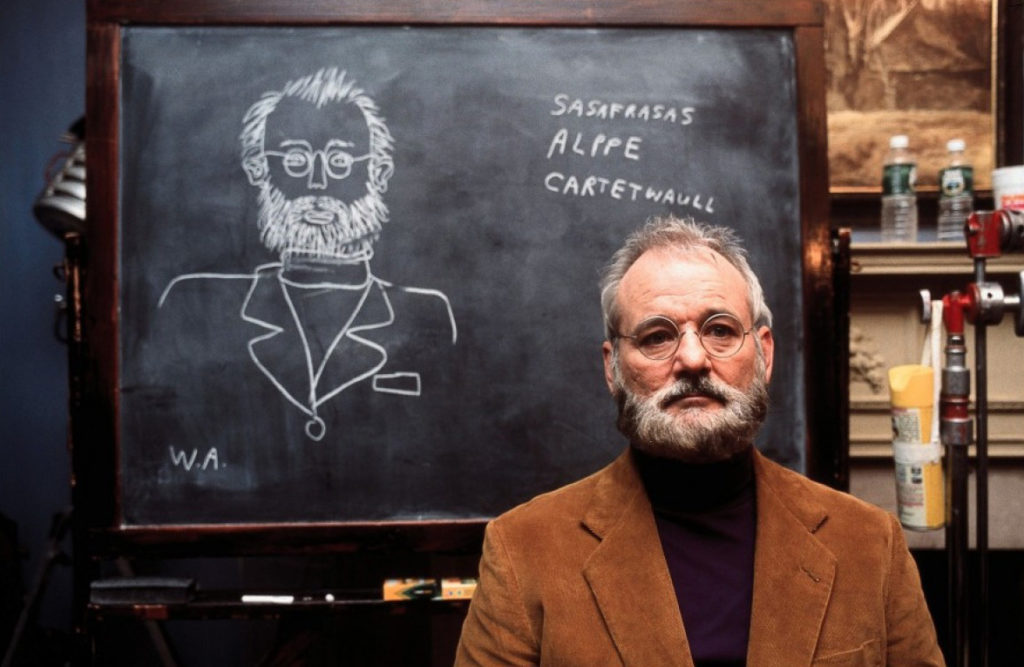
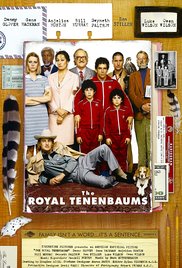 Bill Murray and Wes Anderson are a match made in cinematic heaven. On his second of seven films (so far) with Wes Anderson, Bill Murray plays more of a supporting role in The Royal Tenenbaums, but a role that is not only affected by what transpires within this most dysfunctional family, but that spurs on some of that same dysfunction to comedic effect. As the husband of Margot Tenenbaum (Gwyneth Paltrow), who is adopted, Bill plays Raliegh St. Clair, a man who is a neurologist whom is writing a book about a very complicated condition. While he is deeply in love with Margot, he is not seeing that love reciprocated. The age difference between them is addressed in the film by the narrator (Alec Baldwin) as a reason for Raliegh finding himself cheated on by Margot with her childhood friend Eli Cash (Owen Wilson).
Bill Murray and Wes Anderson are a match made in cinematic heaven. On his second of seven films (so far) with Wes Anderson, Bill Murray plays more of a supporting role in The Royal Tenenbaums, but a role that is not only affected by what transpires within this most dysfunctional family, but that spurs on some of that same dysfunction to comedic effect. As the husband of Margot Tenenbaum (Gwyneth Paltrow), who is adopted, Bill plays Raliegh St. Clair, a man who is a neurologist whom is writing a book about a very complicated condition. While he is deeply in love with Margot, he is not seeing that love reciprocated. The age difference between them is addressed in the film by the narrator (Alec Baldwin) as a reason for Raliegh finding himself cheated on by Margot with her childhood friend Eli Cash (Owen Wilson).
Raliegh ends up confiding in Margot’s brother (through adoption) about his desire to win his wife’s heart back from Eli Cash, not knowing that her brother Richie Tenenbaum (Luke Wilson) secretly has a crush on his sister…who is not really his sister by blood, after all. Through this small role, Bill Murray exudes the same loveable sadness and empathy that drives his characters in other Wes Anderson films, namely Rushmore, and The Life Aquatic with Steve Zissou. Playing a man whose pain and misery are being played off against that of two of the three Tenenbaum siblings, and a close family friend, Murray’s Raliegh St. Clair provides a sure foundation for much of the generational chaos that underpins the dysfunction that exudes from Gene Hackman’s portrayal of the patriarch, Royal Tenenbaum.
Just a few years before Rushmore, Murray had decided to start taking more support roles in various comedies, which not only created memorable moments, but led to more interesting leading roles such as those aforementioned Wes Anderson films (and several more of his that I haven’t mentioned), as well as his role in Sofia Coppola’s Lost in Translation, which earned him rave reviews. As a fan of Wes Anderson, The Royal Tenenbaums was a delightful treat that had long eluded me. Getting to see Bill Murray take on a role that is based on Dr. Oliver Sacks, who inspired the film Awakenings, and infuse it with a little bit of Bill Murray’s other famous scientist roll, Dr. Peter Venkman (Ghostbusters), was a enjoyable experience as Murray walked that line very carefully. Murray is going to appear in his eighth Wes Anderson film in 2018 as a voice actor in Isle of Dogs, but until then, it was great to go back to 2001 to see Murray interact with the likes of Luke and Owen Wilson, Gwyneth Paltrow, Gene Hackman, Danny Glover, Anjelica Huston, and Ben Stiller. As far as I’m concerned, Murray and Anderson should find a way to keep working together as each outing has been an enjoyable affair.
Mad Dog and Glory
(1993, Universal Pictures, dir. John McNaughton)
by Oscar Jackson III
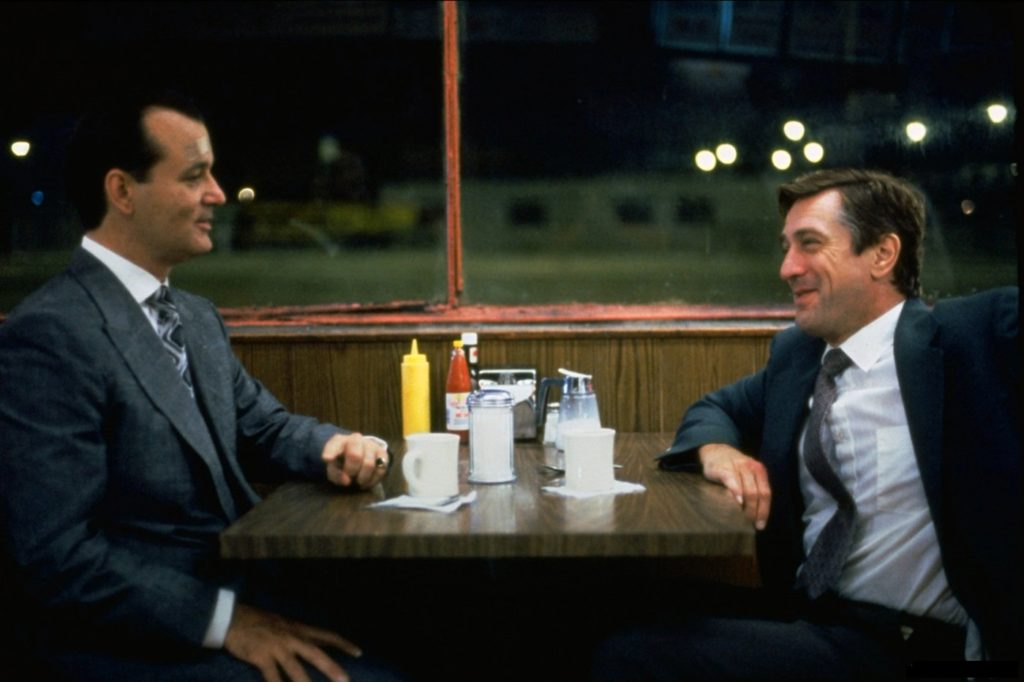
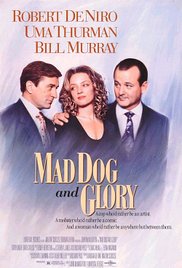 Peculiar and punching above its weight class in a lot of ways, Mad Dog and Glory manages to be more than just an experiment in actors working against type. Robert De Niro plays Wayne Dobie, a Chicago cop, who is anything but what his nickname “Mad Dog” implies. Never having pulled his gun in all his years on the force, Dobie is timid to the point of being unable to accept the friendly invitations of his apartment neighbor, or really have much of any relationships of any kind. Even his photography, one of the few things he is passionate about, he recognizes are weak since the dead victims he shoots are unwilling and passive participants. Following a hunch during a case, Dobie saves money lender Frank Milo (Murray) who takes a liking to the timid Mad Dog and following a night of bonding over booze, sends him Glory (Thurman), a woman trapped in her debts to Milo who has no qualms using her for one of his whims for a week, as a thank you.
Peculiar and punching above its weight class in a lot of ways, Mad Dog and Glory manages to be more than just an experiment in actors working against type. Robert De Niro plays Wayne Dobie, a Chicago cop, who is anything but what his nickname “Mad Dog” implies. Never having pulled his gun in all his years on the force, Dobie is timid to the point of being unable to accept the friendly invitations of his apartment neighbor, or really have much of any relationships of any kind. Even his photography, one of the few things he is passionate about, he recognizes are weak since the dead victims he shoots are unwilling and passive participants. Following a hunch during a case, Dobie saves money lender Frank Milo (Murray) who takes a liking to the timid Mad Dog and following a night of bonding over booze, sends him Glory (Thurman), a woman trapped in her debts to Milo who has no qualms using her for one of his whims for a week, as a thank you.
De Niro is easily the standout here, if for no other reason than the fact that I am so accustomed to his characters being the controlling force or possessing some simmering rage ready to break forth. Dobie is vulnerable, even embarrassingly so. The first time he and Glory make love can best be described as embarrassing, and even though he eventually stands up to Milo for the woman he loves, his anger is more of an anomaly to the character than the realization of who he really is.
Murray is great as Milo. Despite all the evidence, you almost don’t want to concede how bad he is even knowing he is using Glory as a sex slave and is most likely responsible for a few murders. Like so many other comedians, Murray has no issues showing layers, even if Milo is pretty close to 1988’s Scrooged minus the redemption. It helps too that he towers over shorter-than-you-realize De Niro. Their scenes together are worth the price of admission, especially the bonding night and the street brawl.
I also have to mention the obvious care evident in the cinematography and score. This could have been a lazy, paint by the numbers, insert-random-stars-here film, but there is far more here than many may assume. The love-making scenes are more intimate and maybe I’d even say realistic than most that use it as an excuse to toss in some unnecessary nudity, and the street fight reminded me of the Cap/Tony/Bucky fight in Captain America: Civil War in that every blow connects emotionally and physically without being over the top. Elmer Bernstein’s score also stands out.
Scrooged
(1988, Paramount Pictures, dir Richard Donner)
by Jeffrey Knight
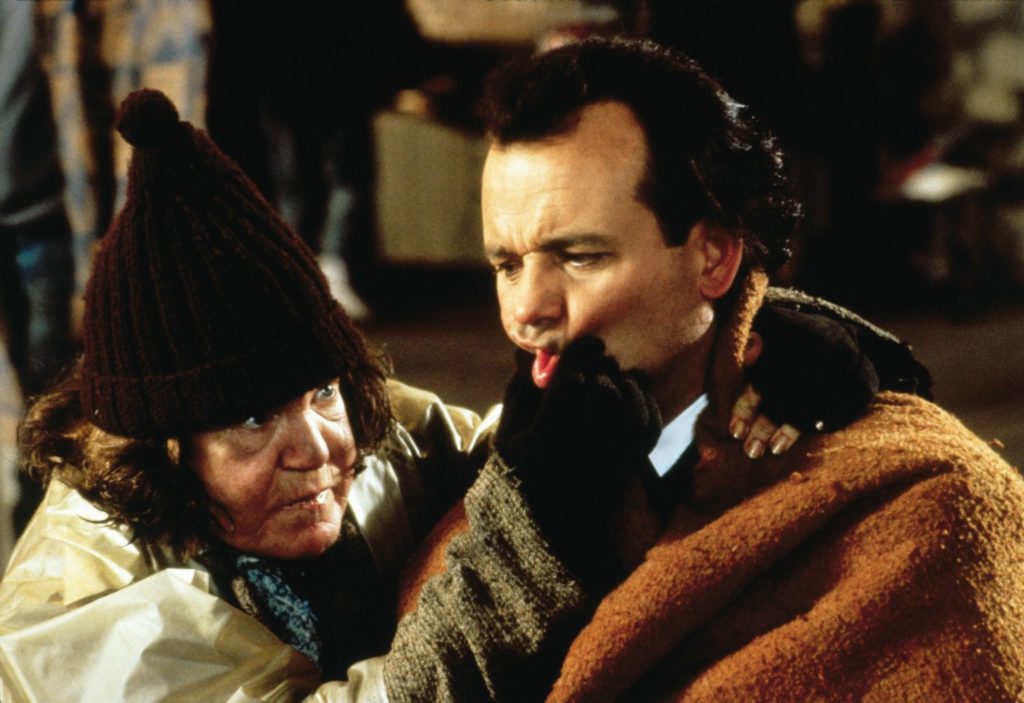
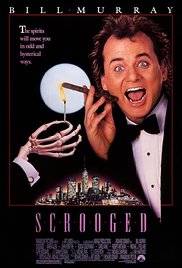 I wanted to like Scrooged, I really did. I’ve passed on watching it these past thirty years since it was panned on its initial release, but it seems to have become a rediscovered holiday classic. Could it be better than its original reception suggested?
I wanted to like Scrooged, I really did. I’ve passed on watching it these past thirty years since it was panned on its initial release, but it seems to have become a rediscovered holiday classic. Could it be better than its original reception suggested?
Scrooged is a loose retelling of Charles Dickens’s “A Christmas Carol.” Bill Murray’s Frank Cross is a heartless TV executive who needs to be taught a very important life lesson by three ghosts that visit him over the course of.., a day and a half? The movie’s timeline isn’t very clear. No points if you guess that Cross takes these lessons to heart and is a changed man by the story’s end.
The movie is an unfunny, lazy mess from start to finish. So why is it considered a ‘classic’ today? I can only guess it is because of the final scene of the film, when Bill Murray is finally let off the leash. When Cross returns from his “Ghost of Christmas Future”-induced nightmare, he hijacks the set of his network’s live production of Dickens’s story. He confesses the errors of his ways, proclaims his love for his old girlfriend, Claire (Karen Allen, always adorable), and rants and raves about the true meaning of Christmas. He comes off as not so much a man whose heart has grown three sizes that day and more like, as someone else put it in another Bill Murray film, “a game show host.” And this is the zone Murray works best in.
There’s always been an anarchic edge to the best Bill Murray performances. That sense that even as his character is trying to play by the rules, he could toss that rulebook out at any moment. When Frank Cross turns his TV show into a sing-along at the end of Scrooged (and he literally tries to get the movie audience to sing along with him!), it’s mostly an ad-libbed performance that adds that anarchic jolt into the movie that it has been missing all along. It’s a reminder of what we’ve always loved best about Bill Murray.
For all his ubiquity today, there was a time in the mid-eighties you couldn’t find Bill Murray anywhere. After his dramatic turn in 1984’s The Razor’s Edge, Murray didn’t appear onscreen again (aside from a brief, but very memorable cameo in Little Shop of Horrors) until Scrooged was released in 1988. He was reportedly considering giving up acting altogether. Furthermore, Scrooged would be the first time Murray had to carry a film by himself. His best-known previous work (Ghostbusters, Stripes, Meatballs, Caddyshack) all had him as part of an ensemble.
Donner later described him as being incredibly nervous: “He’d do anything to avoid getting in front of the camera. He’d tell stories. One minute he’s got his wardrobe on, next he’s running around the set without any clothes on.”
He needn’t have worried. Audiences back in 1988 were ready to welcome him back. Scrooged did just fine at the box-office and can be found all over the TV these days during the holiday season. Not long after Scrooged, he’d get a second chance at this sort of redemption story, Groundhog Day, a true classic and the movie that really put Bill Murray on the path to becoming the ironically cool icon he is today.
Lost in Translation
(2003, Focus Features, dir. Sofia Coppola)
by Taylor Blake
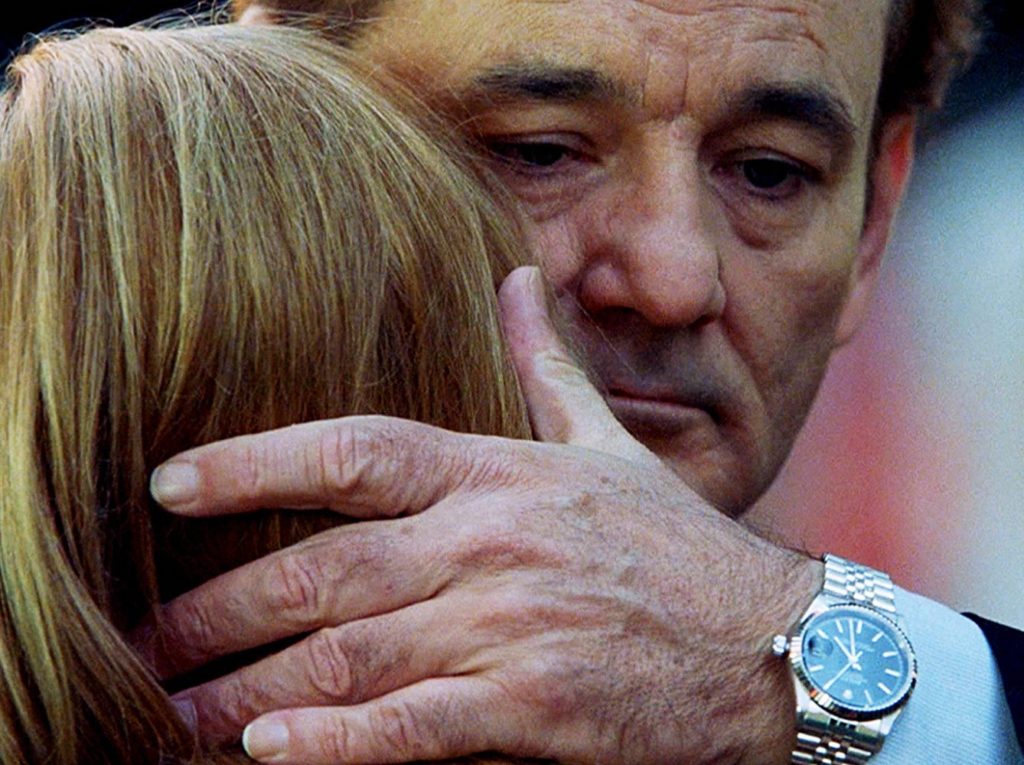
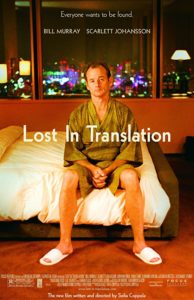 A provocative question popped into my head as the credits rolled for Lost in Translation: Is Bill Murray a good actor, or does he just have a few settings he performs in really well?
A provocative question popped into my head as the credits rolled for Lost in Translation: Is Bill Murray a good actor, or does he just have a few settings he performs in really well?
Some actors lose themselves in the role, and others bring themselves to the role—Bill Murray is the latter. While I’ve liked him in everything I’ve see him in (except maybe Garfield), I can’t decide if he’s really, well, acting. Surely that contrast of dry, stoic wit and goofy, spontaneous charm doesn’t appear just when he’s on camera. He does both drama and comedy convincingly, but he seems to use the same set of tools every time.
His performance as Bob Harris in Lost in Translation feels like the spiritual successor to Groundhog Day. Perhaps if Phil Connors had never been stuck in Punxsutawney, Pennsylvania, for that tiny infinity, this is the mid-life crisis he’d experience. All the despair and yearning we saw on Phil’s face as he was forced to love Rita all alone is near-identical to the despair and yearning we see when Bob sits through hours of inane photo shoots all alone. Although Lost in Translation earned him an Oscar nomination, Groundhog Day is my favorite Murray movie because it taps into both his drama and comedy sides so well.
But that’s more a function of Groundhog Day’s script than simply his performance, and if you can nail loneliness, you can nail your role in a Sofia Coppola film. His charisma and star power are effortless bonuses in both cases, and they especially contribute to the realism of Coppola’s work. Contrast that with Scarlett Johansson, who needed neither charisma nor star power for her role in Translation. (Talented as she is, her draw still isn’t her charisma.) But her greater body of work shows roles more varied in personality even in a shorter career.
To be fair, talent and limited range aren’t mutually exclusive, but like his final message to Johansson in Translation, the answer to this debate is still elusive. I suppose the most responsible thing would be to continue watching Murray’s films to determine the verdict. Poor me.
Broken Flowers
(2005, Focus Features, dir. Jim Jarmusch)
by Sharon Autenrieth
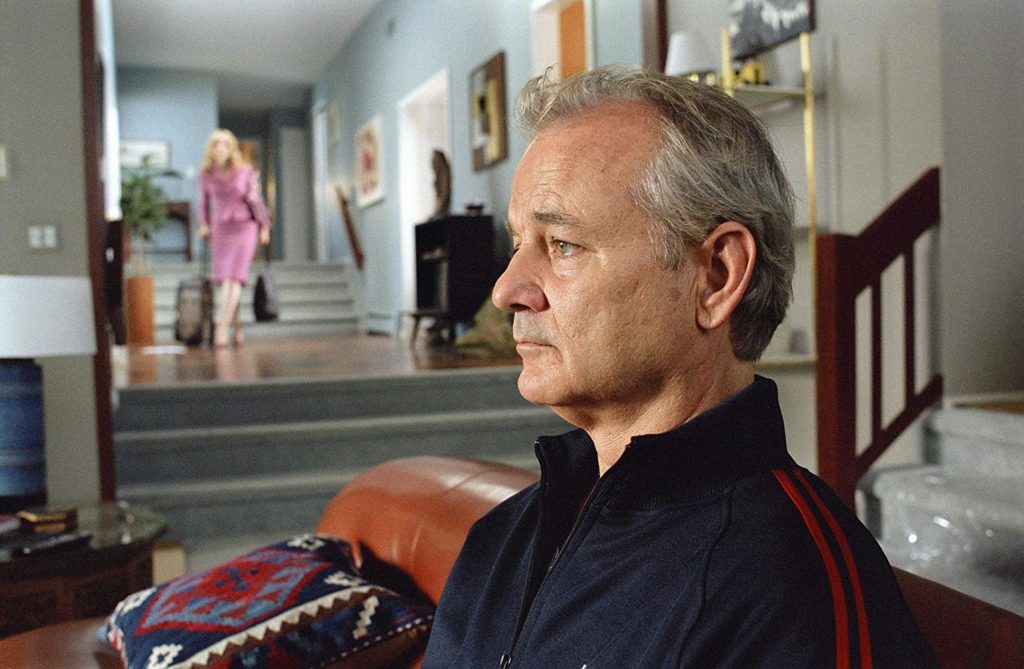
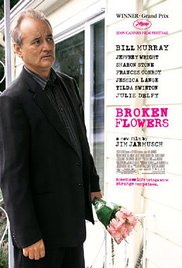 Film critic Ken Tucker used the phrase “depleted man” to describe many of the roles Bill Murray has played in the second half of his career – in movies like Lost in Translation and in all of his collaborations with Wes Anderson. But Murray has never been more depleted, more passive, more blank than he is as Don Johnston in Jim Jarmusch’s Broken Flowers. Don made enough money in computers to retire early and comfortably, and is a lifelong bachelor with a seemingly endless series of girlfriends. He is referred to as a “Don Juan” three times in the film, to his growing consternation. The movie opens with his current girlfriend, Sherry (Julie Delpy) leaving him, calling him an “aging Don Juan” – an unflattering description to be sure. But it’s her other remark (“I’m like your mistress, and you’re not even married”) that tells us more about Don’s character. Don is a man so self-contained, so emotionally chilly, that real emotional intimacy seems an impossibility. Maybe it wasn’t always this way: surely there must have been something in Don to draw so many women to him, something besides the flat affect and the track suits.
Film critic Ken Tucker used the phrase “depleted man” to describe many of the roles Bill Murray has played in the second half of his career – in movies like Lost in Translation and in all of his collaborations with Wes Anderson. But Murray has never been more depleted, more passive, more blank than he is as Don Johnston in Jim Jarmusch’s Broken Flowers. Don made enough money in computers to retire early and comfortably, and is a lifelong bachelor with a seemingly endless series of girlfriends. He is referred to as a “Don Juan” three times in the film, to his growing consternation. The movie opens with his current girlfriend, Sherry (Julie Delpy) leaving him, calling him an “aging Don Juan” – an unflattering description to be sure. But it’s her other remark (“I’m like your mistress, and you’re not even married”) that tells us more about Don’s character. Don is a man so self-contained, so emotionally chilly, that real emotional intimacy seems an impossibility. Maybe it wasn’t always this way: surely there must have been something in Don to draw so many women to him, something besides the flat affect and the track suits.
Don’s shell is very nearly cracked by an anonymous letter in a pink envelope, telling him that he has a nineteen year old son who may show up at any time. Don’s neighbor and only friend, Winston (Jeffrey Wright), an amateur writer of detective novels, sees the letter as a mystery to be solved and sets Don off on a trip to visit the four women from Don’s past who might have sent it. The women are played by standout actresses (Sharon Stone, Frances Conroy, Jessica Lange, and Tilda Swinton) and seem to possess more charisma than this strange man could ever have deserved. They meet Don’s arrival with reactions ranging from warmth to repressed longing to rage – but try as he might to look for clues, Don is unable to crack the case as Winston* intended.
It’s clear that for director Jim Jarmusch, settling the paternity question was never the point of this film. There’s no real closure, no wrapped up ending. Instead, there’s real mystery – not just the kind found in detective novels but the mystery of meaning in one man’s life, and in in the universe. All the clues, all the coincidences, all the red herrings…do they point to something? Or nothing? Is someone or something trying to steer Don in the right direction? Does it matter? Don is changed by his journey, but not in the ways we expect from a more conventional film. A man whose moral philosophy is to live entirely in the present is now forced to reckon with a past that may be living and breathing in the form of a son…or maybe not. Can the son both exist and not exist for Don? Does the search for answers change Don even if he was driven by the wrong question? The ideas at work in Broken Flowers seem like a mashup of Buddhism and Quantum Physics. Whether you find the movie satisfying may depend on your willingness to live with the tension of not knowing. How do you feel about unresolved chord progressions?
Bill Murray is wonderful in this film. He has a Keatonesque ability to convey depths of meaning with only the shift of his eyes or a slight, fleeting smile. In the hands of a lesser performer Don Johnston would be deadly dull and unworthy of our interest or sympathy. But however little he says, however little he does, humanity always radiates from Bill Murray on screen.
* A note about Winston. He is the anti-Don in this film. Winston works three jobs to support his wife and five children, and yet he seems infinitely richer and more fulfilled than Don. For all the sexual partners Don has had, it may be that he is most emotionally intimate with Winston, who pushes insistently into Don’s life over all the (mild) objections. Winston is full of wonder and curiosity; he is vibrant, generous, forgiving, and relentless. Something about Winston reminded me of the love of God, and even Don finds it hard to resist that kind of force.


